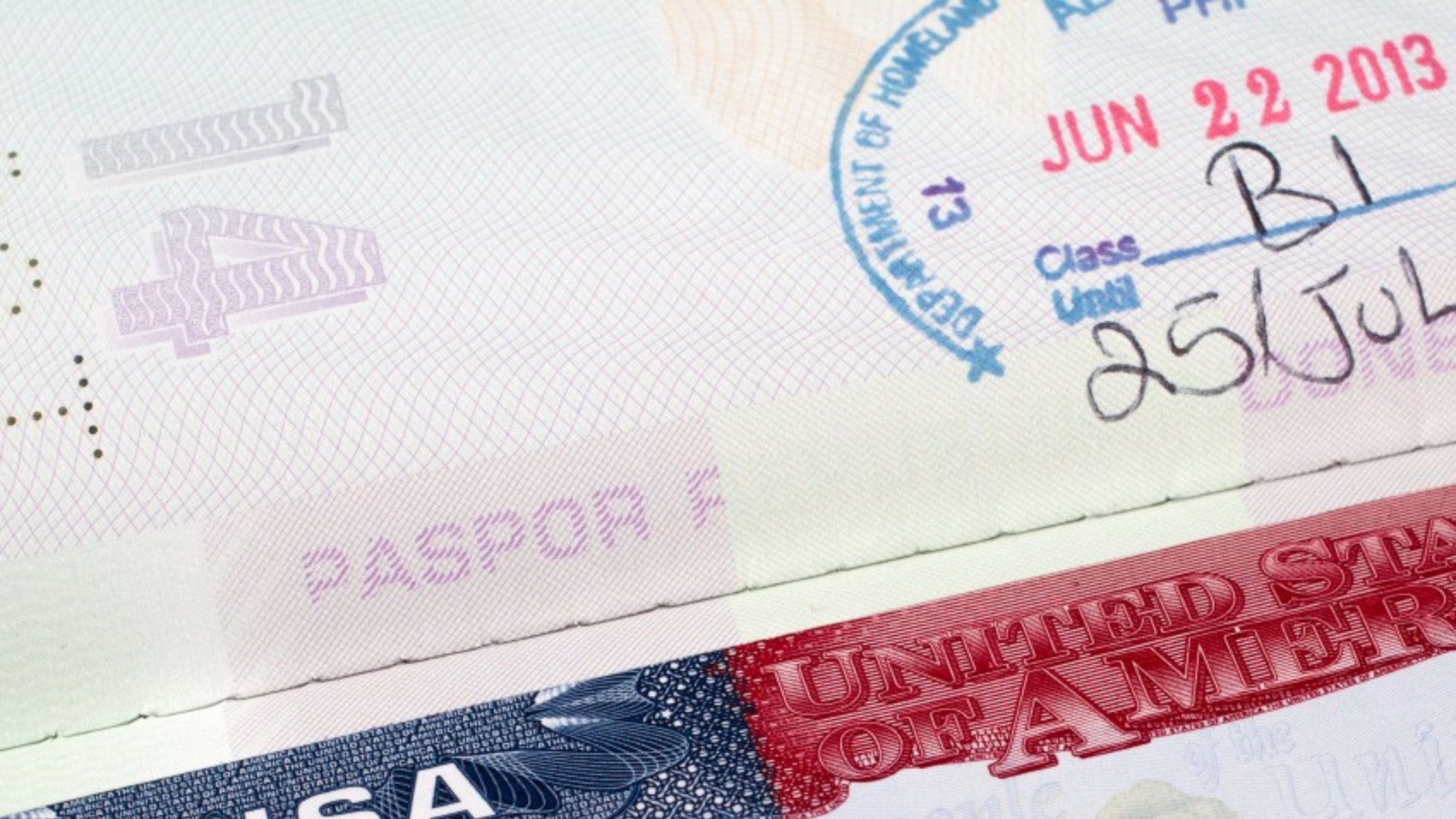Updated on 18.03.2024
Generally, US visa holders or ESTA travelers receive a temporary residence status when entering the USA. We explain the basics of extending and changing status.
Share article:

The status refers to a temporary residence permit in the United States for a specific purpose. The status thus forms the legal basis for a foreign person's stay in the USA and determines the details of the stay. The following information can be found on the entry stamp or form I-94:
Foreign travelers receive residence status each time they enter the USA upon presentation of a valid US visa or a valid ESTA travel authorization. The status is documented at the border by means of an I-94 entry stamp in the passport and at the same time electronically under the I-94 website. In future, entry stamps will no longer be required at border controls.
This means that CBP officers use the corresponding US visa (travel document) or ESTA authorization to decide for each entry whether the person may enter the United States and, if so, for how long.
Sometimes the technically incorrect term US visa status is also used. This always refers to the residence status or status for the USA.
Accordingly, a distinction is made by the US authorities between the approved US visa (as a travel document in your passport) or the ESTA authorization with which you "request entry" at the border and the (residence) status. The US border officers determines your status when you enter the country. The status describes the period of time during which you are actually physically allowed to stay in the United States and when you must leave the USA at the latest. This status often differs from the US visa in the passport – can therefore be issued for a shorter or longer period depending on the visa category and purpose of stay.
Do not confuse the validity of your status with the validity of your visa. Nonimmigrant visas allow entry into the US for a limited time and for a specific purpose, e.g. employment or study, and are valid for a limited period of time (see expiration date on the visa). Within this period, visa holders can request entry to the United States.
In order to clarify the status under which a foreign individual is staying in the USA, the respective category (Nonimmigrant Class of Admission) is stored in the I-94 when entering the USA.
These Class of Admission (COA) codes consist of a combination of letters and numbers and largely correspond to the respective nonimmigrant visa category.
| Status for US visas | |
|
|
There are the following two distinctions in ESTA status:
In some cases, however, the designations are more detailed and contain additional information on the purpose of the stay.
US visitor visas
Persons traveling to the United States for business purposes are generally granted B-1 status. However, USCIS form I-539 for extensions or changes of status within the United States requires more detailed information on the purpose of the business stay in the USA. The following distinctions are made:
US work visas
The USCIS / CBP have been using new COA codes for several years to distinguish between spouse and child(ren). The suffix "S" (for spouse) makes it clear that the person traveling is the spouse:
A valid form I-94 with one of these new codes is considered proof of employment authorization for spouses and replaces the separate application for a general work permit (Employment Authorization Document).
Accompanying children in the above categories receive the suffix "Y" in their respective status upon entry into the United States.
Typically, the residence status of visa holders granted by CBP is extended upon exit and re-entry to the United States – provided the US visa is still valid and in compliance with all possible travel regulations.
If the granted period of stay threatens to expire soon, holders of a nonimmigrant visa must either leave the country or, alternatively, can check the possibility of extending their residence status on site or – if an extension of status is not possible – change to another status so that they do not stay in the USA unlawfully or illegally (= overstay).
In the event of an extension of status or a change of status, it may be possible to extend your stay in the United States without having to leave the country.
The two most common reasons for applying for an extension of status in the USA are:
In the case of a change of status, the focus is usually on a change in the purpose of residence. This means that the reason for the stay in the USA has changed and must be legalized by changing to a different status that enables this purpose. An example would be entry under B-2 status as a tourist and the change to F-1 due to a study place offer.
It is worth checking carefully whether the option of extending your status locally in the USA makes sense when your residence status expires, and whether it is likely to be successful. This is because as soon as you leave the USA, the status becomes invalid and you will need a valid US visa to re-enter the country, which you may have to apply for at the US consulate / US embassy in your home country with the relevant application documentation (if your previous US visa has expired or does not cover the intended purpose of your stay).
Whether an extension of status or a change of status can be filed with the U.S. Citizenship and Immigration Services (USCIS) within the United States depends primarily on the visa category with which you are currently residing in the United States.
Holders of almost all nonimmigrant visas are eligible to apply for an extension of their authorized period of stay or change of their nonimmigrant status.
However, a few basic requirements must first be met:
In addition, depending on the category, further requirements must be fulfilled or proof must be provided.
The following nonimmigrant categories generally entitle you to an extension of status and / or a change of status:
Please note that there are nonimmigrant visa categories that entitle you to an extension of your stay in the US, but do not allow you to change to another nonimmigrant category.

There are certain US travelers who cannot apply for an extension of stay and / or change of status. These individuals are required to leave the United States in a timely manner prior to the date indicated on the I-94, i.e. the maximum permitted duration of stay. This concerns the following individuals:
In addition, there are other cases in which the stay in the United States cannot be extended. It must therefore always be checked on a case-by-case basis whether an application procedure is possible and reasonable.
Particularities of a status extension
Persons who have exhausted the maximum residence status of a particular visa category cannot obtain a further status extension (e.g. L-1 or H-1B).
Particularities of a change of status
The application for extension of status or change of status must be submitted to the U.S. Citizenship and Immigration Services (USCIS) before expiration of the I-94 – i.e. before the expiration of the legal residence status and thus within the United States. The application is filed either
Two main forms are important in the application process: the I-129 and the I-539. Which form is relevant or whether both forms are required depends on the respective nonimmigrant category. Whether or which additional application documents must be submitted must be individually inquired with the USCIS.
I-129 Petition for a Nonimmigrant Worker
Using the I-129 form, nonimmigrant workers apply for an extension of their residence status and, at the same time, an extension of their work permit or a change of status to a (different) work visa category. This includes the following visa categories:
I-539 Application to Extend / Change Nonimmigrant Status
The I-539 is used for extension or change of status for the following visa categories:
Forms I-129 + I-539
If an individual is in a status in the United States that authorizes employment and is to be extended, form I-129 must be filed with the USCIS by the US employer. If this person is currently accompanied by family members (spouse and unmarried children under the age of 21) in the derived categories in the United States, a joint application can be filed. For this purpose, the I-539 form is submitted together with the I-129 form for the family and processed at the same time by the US immigration authority USCIS.
For example: If the status and thus the work permit of an L-1 person is to be extended, the L-2 status extension procedure for the accompanying family members can be submitted directly in parallel to the relevant US authority (I-129 + I-539).
However, it is also possible to submit the applications separately. The same applies to possible change of status procedures in the area of employment.
I-539A Supplemental Information for Application to Extend / Change Nonimmigrant Status
The I-539A is part of form I-539. If you want to apply for an extension of status or a change of status for more than one person, you need to sign and submit a separate form I-539A for each additional applicant listed.
The I-539A is used, for example, when spouses and unmarried children under the age of 21 are included as co-applicants in the main applicant's application for the same extension or change of status. This is only possible if they all have the same status or a derived status.
Under certain circumstances, the I-539 form can be filed electronically with the USCIS. To qualify, applicants must be individual applicants (without co-applicants, legal or accredited representation) in the United States with the following status:
Particularity: F-2 or M-2 holders must compare the expiration date of their residence status with that of their spouse or parent who holds F-1 or M-1 status. If the expiration dates are

The procedure for an online application is as follows:
If you would like to know whether you can use the online application form for an exentsion of stay or a change of status, please visit the website of the USCIS.
Multiple applicants (e.g., family) may, of course, submit their respective applications for status renewal individually online, but they will incur higher fees than if they use the "joint application submission" method by mail.
The U.S. Citizenship and Immigration Services recommends submitting the application at least 45 days before the I-94 expires. Theoretically, however, the application can still be submitted on the last day of the I-94 validity. The decisive factor is the receipt date of the USCIS (= official receipt of the application), not the postmark.
I-539 procedures tend to be relatively lengthy and the average processing times are around 3 to 6 months (depending on category and USCIS Service Center); in some cases even longer.
An accelerated procedure (Premium Processing) is only possible for status extensions using the I-129 form (e.g. as part of L-1 or H-1B applications) and for I-539 applications in categories F-1, F-2, M-1, M-2, J-1, J-2. The USCIS will then process the status extension or change of status application within 15, 30 or 45 business days, depending on the category (provided there are no queries).
The fees for an application for extension of status or change of status via I-539 form vary depending on whether the I-539 application is filed by mail or online and depending on the status. Generally, paper filing costs 470 $ and online filing 420 $.
The following applicants are exempt from the I-539 application fee and therefore pay $0:
The application fees for an I-129 change of status or extension procedure are considerably more cost-intensive and are not regulated uniformly. The costs vary depending on the category or, for example, the size of the company, but can easily amount to several thousand US dollars. You can find more information on this on the USCIS website.
You may pay the processing fee for forms I-539 and I-129 by money order, personal check, cashier's check, or with a credit card or debit card using Form G-1450 (Authorization for Credit Card Transactions).
Furthermore, additional costs may be incurred for certain applicants if the Premium Processing service is booked as an option. For an additional fee of 2,805 $ with the I-129 or 1,965 $ for I-539 applications in the F-1, F-2, M-1, M-2, J-1 and J-2 categories, USCIS agrees to process the application more quickly (within 15, 30 or 45 business days, depending on the category).

You can find more information about the different visa fees, other possible costs and the current payment methods on our fees page.
Tolerated status exemption
Normally, visa holders lose their legal resident status if they continue to stay in the US after the I-94 expires. However, if the I-94 expires while the application process for extension of stay or change of status is ongoing and the USCIS has therefore not yet made a decision, you can continue to reside legally in the United States on the basis of an exception (until the final decision is made) – in a kind of "tolerated status".
However, the basic requirement is that you have submitted the application on time, i.e. before the old status expires. Please also note that although you will continue to be tolerated during the processing phase, you will be subject to further conditions.
For example: If your employer files an I-129 extension application for your work permit and your residence status in the USA on time, you can stay in the USA legally tolerated until the USCIS has made a decision. However, you may only continue to work for your previous employer for a maximum of 240 days after your I-94 status is terminated.
Another example: If you apply for a change of status in the USA with I-539 from B-2 tourist to F-1 student, you are generally not allowed to start studying until the US immigration authority USCIS has officially changed your status.
Do not leave the country
As long as your application for extension of status or change of status in the USA is still pending and no final decision has been made, you may not leave the United States. This also includes short trips to Canada or Mexico. If you nevertheless leave the United States, you officially give up your status. Your current application procedure will lapse at that moment and you will automatically withdraw your application when you leave the US. As a result, you will receive an official rejection from the US authorities.
Exceptions are possible in the area of US work visas. These must be checked carefully in advance.
An application for extension or change of status does not automatically guarantee that the extension or change will be approved. The USCIS reviews each application very carefully and reserves the right to deny applications.
If the application for extension of stay or change of status is rejected, you must leave the United States immediately. This is often accompanied by the US visa (on the basis of which you entered the country) being declared invalid.
Now it's official: The U.S. Citizenship and Immigration Services (USCIS) is suspending the mandatory biometrics appointments for certain I-539 applicants as of October 1, 2023.
The biometrics appointment is an in-person appointment at a USCIS Application Support Center (ASC) in the United States, where the applicant will be photographed and fingerprinted.
In the past, the biometrics appointment was mandatory for applications for change of status as well as for certain status extension procedures and was subject to a fee of $85 (Biometrics Service Fee).
Nonetheless, USCIS may ask applicants to appear for an in-person interview or provide biometrics (fingerprints, photograph, and / or signature) at any time to verify identity, obtain additional information, and conduct background and security checks, including a Federal Bureau of Investigation (FBI) criminal history record check, before making a decision on your application or petition.
We advise you on the choice of the appropriate visa category and take over the complete processing for you or your company.

Date:
Wir und unsere Partner nutzen Cookies, um personenbezogene Daten wie z.B. Browsing-Daten zu speichern und abzurufen, um z.B. Inhalte und Werbung bereitzustellen und zu personalisieren sowie die Verwendung der Website zu analysieren und das Benutzererlebnis zu verbessern. Sie erfahren mehr über die Zwecke, für welche wir und unsere Partner Cookies einsetzen, wenn Sie unten auf den Button „Cookie Einstellungen“ klicken. Hier können sämtliche Einstellungen auch geändert werden. Nachträglich kann man jederzeit seine Cookie-Auswahl überdenken oder seine Einwilligung widerrufen, indem man auf den Link zu den Cookie-Einstellungen im Footer unserer Webseite klickt. Beachten Sie bitte, dass das Blockieren einiger Cookie-Typen unsere Möglichkeiten zur Bereitstellung von auf Ihre Interessen zugeschnittenen Inhalten haben kann oder einige Funktionen der Webseite nur eingeschränkt zur Verfügung stehen.
Durch klicken auf “Alle Cookies akzeptieren” stimmen Sie unserer Nutzung und der Weitergabe Ihrer Daten an unsere Partner zu.